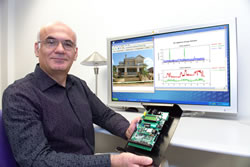
|
|
April 2007 |
Monitoring System Forms the Backbone of Research Projects You may have seen the recent technical report on the novel “NightCool” cooling concept assessment in scale test buildings written by Danny Parker and John Sherwin (the complete report is available in PDF (1.7 MB) at www.fsec.ucf.edu/en/publications/pdf/FSEC-CR-1692-07.pdf). It gives the results of an interesting research project carried out at FSEC which is demonstrating a 20 percent or greater reduction in space cooling loads than previously achievable with the very best existing building and equipment technologies. One thing that stands out is the rigor and precision of the research that allows for such detailed testing.
This project benefited from the experience and pains-taking exactness with which FSEC engineer John Sherwin instrumented the facility. And while the extensive work of the researchers is key to the findings, few people are aware of the “behind the scenes” work of FSEC’s Information Technology group that provides the data logging/acquisition technology and support for all of the center’s research projects both on-site and around the country. “I guess we’ve probably set up data acquisition systems for more than a thousand research projects over the years, said Safvat Kalaghchy, director of the office. “No matter how involved the research project is, we can instrument with appropriate transducers and data acquisition systems to gather the needed information and get it into our databases for use by the researchers. If we can’t do our job right, then the researchers just won’t be able to do theirs.” Kalaghchy explains that “There’s really not one standard procedure we follow on projects because every project is different. We must be able to provide the sensors to monitor anything from flow rates, levels of fluids in a tank or detailed power consumption to humidity levels, heat flow, wind speed and other weather conditions. Our inventory includes literally thousands of sensors and hundreds of data loggers, so the sky is the limit to what we can do.” A typical photovoltaics research project, for example, might call for two dozen sensors, allowing the researcher to study DC output, the AC output from the PV system, the load in the house and other variables. If it’s a buildings project, Kalaghchy noted that many more sensors might be needed to measure power and appliance use, thermostat set points, actual humidity levels, pressure levels and dew points, among others. But just gathering the needed data isn’t enough. “What really makes our work so valuable to the researchers,” he added, “is that we can connect to the sensors by phone, internet or even by satellite to collect data just about anywhere. We then feed this data into our computer system and automatically generate reports giving the information and data the researcher needs. What this means, for example, is that the system collects data on an ongoing basis (such as every 15 minutes) over many weeks, then crunches it down to create a 24 hours representative day so the researcher can quickly see trends or patterns. “The researcher doesn’t have to look at every single data point,” Kalaghchy explained, “but only needs to see the quick numbers. In the NightCool project, for example, we gathered detailed data on two side-by-side test buildings that were built on our site specifically for this research. Our sensors were able to accurately measure attic temperatures, outside weather conditions -- including complex-to-measure sky temperature-- and many other variables, and provide an automatically generated report every day that let the researchers get results in minutes rather than spend hours calculating them. The complete data is there for them but they can get much of what they need almost instantaneously.” FSEC displays data collection results on a number of Web sites, so you can see for yourself the kinds of information generated that is so useful to researchers. All monitored projects are hosted by the Information Monitors Web site. Go to www.infomonitors.com and click on “Efficient Homes” under “Live Demos.” You’ll get an idea of the types of data that can be collected by looking at this occupied home. Data ranges from the current energy use of the water heater to the temperature in the attic. You can select past dates and see how the energy use varied in different weather conditions, for example. Or click on the “PV at Disney World” listing under “live demo sites” and you can view the performance of the PV system installed at the Disney Wilderness Preserve, viewing current performance of the PV system as well as current weather. A number of monitored sites are posted on the Web pages for education and research purposes, and they will help you appreciate what goes on behind the scenes to help our researchers do their work. You can get more information on FSEC’s data acquisition capabilities at our Photovoltaics and Solar Thermal monitoring pages. |
